Related Research Articles

An exploitation film is a film that tries to succeed financially by exploiting current trends, niche genres, or lurid content. Exploitation films are generally low-quality "B movies", though some set trends, attract critical attention, become historically important, and even gain a cult following.

Blood Feast is a 1963 American splatter film. It was composed, shot, and directed by Herschell Gordon Lewis, written by Allison Louise Downe from an idea by Lewis and David F. Freidman, and stars Mal Arnold, William Kerwin, Connie Mason, and Lyn Bolton. The plot focuses on a psychopathic food caterer named Fuad Ramses (Arnold) who kills women so that he can include their body parts in his meals and perform sacrifices to his "Egyptian goddess" Ishtar.
Bumfights is a video series produced by Indecline Films. The debut release titled Bumfights Vol. 1: A Cause for Concern features primarily high school fights caught on tape and homeless men in the San Diego, San Francisco, Los Angeles, and Las Vegas metropolitan areas attempting amateur stunts in a style inspired by the popular MTV series Jackass. It was produced by Ryen McPherson, with friends Zachary Bubeck, Daniel J. Tanner, and Michael Slyman, as Indecline Films. Contrary to its title, the video does not depict homeless men actually fighting, but instead a compilation of street fights caught on tape and homeless men performing in skits and stunts.

Thelma White was an American radio and film actress. White is best known for her role in the 1936 exploitation film Reefer Madness.
Something Weird Video is an American film distributor company based in Seattle, Washington. They specialize in exploitation B to Z films, particularly the works of Harry Novak, Doris Wishman, David F. Friedman and Herschell Gordon Lewis.

Herschell Gordon Lewis was an American filmmaker, best known for creating the "splatter" subgenre of horror films. He is often called the "Godfather of Gore", though his film career included works in a range of exploitation film genres including juvenile delinquent films, nudie-cuties, two children's films and at least one rural comedy. On Lewis' career, AllMovie wrote, "With his better-known gore films, Herschell Gordon Lewis was a pioneer, going further than anyone else dared, probing the depths of disgust and discomfort onscreen with more bad taste and imagination than anyone of his era."

Mom and Dad is a feature-length 1945 film directed by William Beaudine, and largely produced by the exploitation film maker and presenter Kroger Babb. Mom and Dad is considered the most successful film within its genre of "sex hygiene" films. Although it faced numerous legal challenges and was condemned by the National Legion of Decency, it became one of the highest-grossing films of the 1940s.

Howard W. "Kroger" Babb was an American film producer and showman. His marketing techniques were similar to a travelling salesman's, with roots in the medicine show tradition. Self-described as "America's Fearless Young Showman", he is best known for his presentation of the 1945 exploitation film Mom and Dad, which was added to the National Film Registry of the Library of Congress in 2005.

"My Blue Heaven" is a popular song written by Walter Donaldson with lyrics by George A. Whiting. The song was used in the Ziegfeld Follies of 1927. It has become part of various fake book collections. Its musical composition entered the public domain on January 1, 2023.

The Bellboy and the Playgirls is a 1962 American film by Francis Ford Coppola and Jack Hill. The film is a re-edited version of a West German film of 1958 originally titled Mit Eva fing die Sünde an [Sin Began with Eve], directed by Fritz Umgelter with Coppola and Hill shooting nudity inserted into the film for an American release.
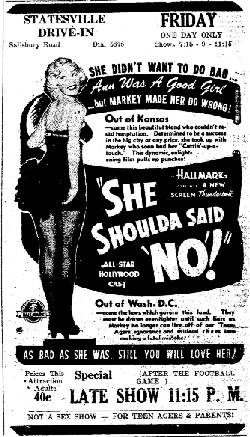
She Shoulda Said No! is a 1949 exploitation film that follows in the spirit of morality tales such as the 1936 films Reefer Madness and Marihuana. Directed by Sam Newfield and starring Lila Leeds, it was originally produced to capitalize on the arrest of Leeds and Robert Mitchum on a charge of marijuana conspiracy.
A square-up was a common feature of exploitation films in the 1940s and 1950s. With the exception of most burlesque features during the 1950s, the films would begin with a written message about what social or moral issue the film was planning to address. For instance, She Shoulda Said No! contained a square-up concerning youth drug abuse, and Child Bride the issue of child marriage.
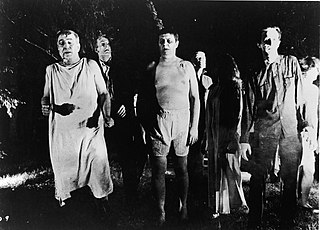
Z movies are low-budget films with production qualities lower than B movies.

The 1960s and 1970s marked the rise of exploitation-style independent B movies; films which were mostly made without the support of Hollywood's major film studios. As censorship pressures lifted in the early 1960s, the low-budget end of the American motion picture industry increasingly incorporated the sort of sexual and violent elements long associated with so-called ‘exploitation’ films. The demise of the Motion Picture Production Code in 1968 coupled with the success of the exploitation film Easy Rider the following year fueled the trend throughout the subsequent decade. The success of the B-studio exploitation movement had a significant effect on the strategies of the major studios during the 1970’s.
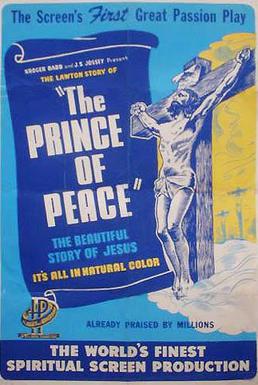
The Lawton Story of "The Prince of Peace", originally released as The Lawton Story and later reissued as The Prince of Peace, is a religious-themed film that later made the roadshow rounds presented by exploitation pioneer Kroger Babb. Filmed in Cinecolor in 1948, it is based on an annual passion play in Lawton, Oklahoma, "The Prince of Peace," created in 1926 by Rev. A. Mark Wallock. This Easter pageant became immensely popular among locals, attracting as many as 250,000 people.
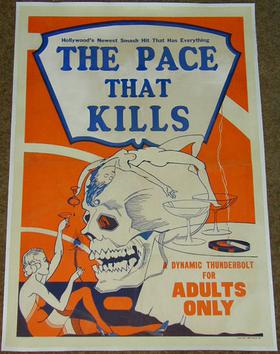
The Pace That Kills is a 1935 American exploitation film directed by William O'Connor. The film, starring Lois January, tells the story of Jane Bradford, who gets involved with a drug dealer and becomes addicted to cocaine. Similar to other movies of the genre, the final film was a reissued work with additional scenes, mostly using footage from the earlier silent The Pace That Kills (1928).

Is Your Daughter Safe?, also known as The Octopus, was an early American silent exploitation film produced and directed by S. S. Millard. Written by Max Abramson, it was originally released in 1927 and presented around the United States in the following years.
Jack S. Jossey was an American film producer and businessman. A Seagram stockholder, he helped finance and film many exploitation films during the 1940s, including Mom and Dad and The Prince of Peace.
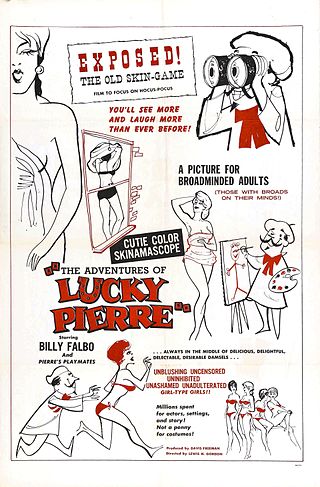
The Adventures of Lucky Pierre is a 1961 nudie cutie film created by exploitation filmmakers Herschell Gordon Lewis and David F. Friedman. The first of its kind to be filmed in color, the film starred comedian Billy Falbo. It was unique for its time and genre, adding successful comedy to the nudity and sensationalist material.

Lost Planet Airmen is a 1951 black-and-white American science fiction film produced and distributed by Republic Pictures, which is actually the feature film condensation of their 1949 12-chapter serial, King of the Rocket Men. Lost Planet Airmen was directed by Fred C. Brannon and written by Royal K. Cole and William Lively. The lead actors in Lost Planet Airmen were Tristram Coffin and Mae Clark.
References
- 1 2 3 Feaster, 119.
- ↑ Schaefer, 326.
- ↑ Friedman, 222.
- 1 2 Feaster, 52.
- 1 2 Friedman, 231.
- ↑ Friedman, 230.
- ↑ Friedman, 232–235.
- 1 2 3 Schaefer, 62.
- ↑ Schaefer, 59.
- ↑ Schaefer, 145.
- ↑ Schaefer, 146–147.
- ↑ Friedman, 230–233.
- ↑ Internet Movie Database – S. S. Millard.
- ↑ Internet Movie Database – Nick Millard.
- ↑ Schaefer, 175.
- 1 2 Schaefer, 174.
- ↑ Schaefer, 179.